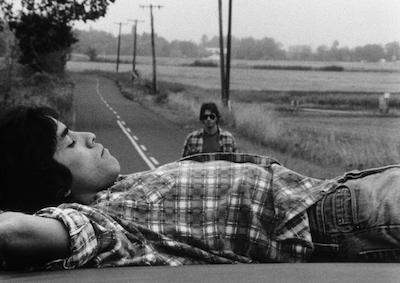Pictured above: Mala Noche (dir. Gus Van Sant, 1986)
Patrons who have not registered online may wait in the standby line. Any seats remaining 15 minutes before showtime will be released to standby patrons. Please review our COVID-19 safety policies.
Mala Noche
Bad Night
1986
Gus Van Sant’s incandescent debut feature Mala Noche manages to prefigure the American indie aesthetic, the ’90s New Queer Cinema, and his own storied career while staying firmly on the pavement in his local Portland, Oregon queer and poetry scenes. Adapting a 1977 memoir about Walt, a liquor store clerk who romances Mexican men in the down-and-out Pacific Northwestern city, Van Sant (b. 1952) films the gay experience as classical cinematic masculinity. With heroic weaseliness and youthful joie de vivre, Walt (Tim Streeter) chases the objects of his lust down these mean streets. As hard-driving and hard-edged as any screen hero, Walt’s very presence within the film poses a deceptively simple question: Who is brave enough to pursue desire, no matter what? When Walt casually remarks, “Do I need him that badly? Am I that desperate? Of course I am,” never has glibness been rendered so heartbreaking.
Yet the grimy, two-tone Mala Noche is matter-of-fact that Walt’s attention is often exploitative. He objectifies and commodifies these undocumented men while their human warmth and vulnerable lives take over the story. Three years before the term “intersectionality” was coined, Mala Noche examines the slip between identities of machismo and submissiveness, the privileged and the impoverished, the free and the kept, stranger and lover, native and American. But Van Sant keeps the most predictable pain off-screen, exploring fresh experiences and echoing Walt’s scrappy choice to will his sexuality into dive-bar normalcy.
Van Sant’s beat-inspired rebellion explodes in all directions within his 16mm black-and-white filmstock, breaking the rules of politics and love, leading-man mores and filmmaking decorum. But while his style became endlessly changeable, his commitment to issues of class and queer life continued from the brash Mala Noche through its delicate, full-color inversion in My Own Private Idaho, to the eight-Oscar-nominated juggernaut Milk over 20 years later. But it all began here, on a bad night in Portland.
—Nathan Rulf
35mm, b&w, 78 min. Director: Gus Van Sant. Based on Mala Noche: And Other “Illegal” Adventures by Walk Curtis. Screenwriter: Gus Van Sant. With: Tim Streeter, Doug Cooeyate, Ray Monge, Nyla McCarthy.
Hide and Seek
1996
New Haven-born filmmaker Su Friedrich (b. 1954) is a pivotal force in the establishment of a queer cinematic mode and aesthetic, her legacy cemented through her 24-film body of work and her veneration in seminal queer theories and histories, including Andrea Weiss’ Vampires and Violets: Lesbians in the Cinema (1992) and 1993’s Queer Looks: Perspectives on Lesbian and Gay Film and Video. Her second film, the silent, defiant Cool Hands, Warm Heart (1979), is just one of her early works that conjures her experience with still photography and the avant-garde tradition, while her Sink or Swim (1990), which in 2015 was chosen for inclusion in the National Film Registry by the Library of Congress, begins to explore the methods that emerge fully formed in one of her longest films, Hide and Seek.
Claims avant-garde choreographer and filmmaker Yvonne Rainer, “Hide and Seek is A Girl’s Own Story (Campion, 1984) for lesbians … a rich and provocative tapestry that assaults complacent assumptions about pubescent desire and lesbian identity.” Mining her own experience as a young girl for Hide and Seek, Friedrich daringly immerses her viewer in her own 1960s adolescence via the uncharted angle of a tweenage lesbian awakening. Young Chels Holland plays the prepubescent Lou, a tomboy who prefers adventures with the guys to sleepovers with the girls. After attempting to hide her first period from everyone (even herself), Lou pivots to developing her female friendships, luxuriating in nursery rhyme clapping games, bedroom forays into “light as a feather, stiff as a board,” and curious peeks at a father’s hidden Playboy. These constructed narrative moments are mixed with documentary interviews with lesbians of various ages discussing their burgeoning lesbian identities alongside archival footage of fascinatingly outmoded sex education films likely seen by Friedrich herself in her middle school classroom. Friedrich lives, teaches and continues to work in New York City.
—K.J. Relth-Miller
16mm, b&w, 63 min. Director: Su Friedrich. Screenwriter: Su Friedrich, Cathy Nan Quinlan. With: Chelsea Holland, Ariel Mara, Linzy Taylor, Sarah Jane Smith, Alicia Manta. Print courtesy of Canyon Cinema.






 Mobile Navigation
Mobile Navigation

